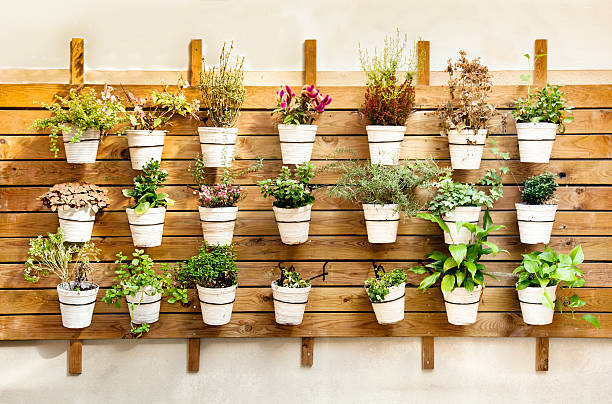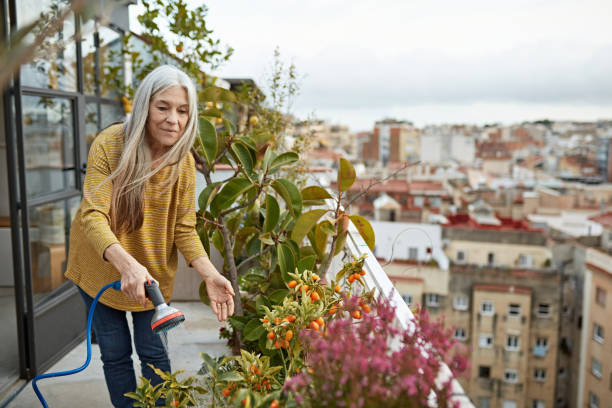Patio gardens offer simplicity and convenience compared to traditional gardening methods. With their compact size and controlled environment, patio gardens require less maintenance, watering, and weeding, making them ideal for individuals with busy lifestyles or limited outdoor space.
Having a patio garden offers a myriad of benefits that extend beyond mere aesthetics. Firstly, cultivating a patio garden allows individuals to connect with nature amid urban living. It provides a serene sanctuary where one can escape the stresses of daily life and immerse themselves in the therapeutic beauty of plants and flowers. Spending time in a patio garden has been shown to reduce stress levels, promote relaxation, and improve overall mental well-being. Moreover, gardening has been linked to physical health benefits such as increased physical activity, improved mood, and better cognitive function.

A patio garden provides an opportunity to grow fresh produce right at home. Whether it’s herbs, vegetables, or fruits, having access to homegrown produce encourages healthier eating habits and promotes sustainability. Growing your food allows you to control the quality and freshness of your consumption while reducing your carbon footprint by minimizing transportation emissions associated with store-bought produce. Additionally, tending to a patio garden fosters a deeper appreciation for the environment and the importance of sustainable living practices, ultimately fostering a stronger connection to the natural world.
Urban living often means limited outdoor space, but you can still enjoy the delights of gardening. Patios, balconies, and even small corners can be transformed into lush green sanctuaries with creativity and planning. Patio gardens add charm to your living space and provide a therapeutic escape from the hustle and bustle of city life.

Here are some of the best ways to create and maintain a thriving patio garden:
1) Assess Your Space
Before you begin, take a good look at your patio area. Note the sunlight it receives throughout the day and the available space for containers or planters. Understanding your space’s unique characteristics will help you select the right plants and design your garden layout effectively.
2) Choose the Right Plants
Selecting the right plants is crucial for the success of your patio garden. Consider the amount of sunlight your space receives and choose plants that thrive in those conditions. Opt for a mix of flowers, herbs, vegetables, and foliage plants to add variety and visual interest to your garden. Some great options for patio gardens include:
- Herbs like basil, mint, rosemary, and thyme
- Compact vegetables such as cherry tomatoes, peppers, and lettuce
- Colorful flowers like petunias, marigolds, and geraniums
- Foliage plants like ferns, hostas, and spider plants

3) Container Selection
When it comes to containers, the options are endless. Choose containers that complement your patio’s aesthetic while providing ample space for plant growth. Ensure that your containers have drainage holes to prevent waterlogging, which can lead to root rot. You can use traditional terracotta pots, lightweight plastic containers, hanging baskets, or even repurpose old crates and buckets for a rustic look.
4) Soil and Fertilizer
Use high-quality potting soil formulated explicitly for container gardening. Potting mixes are lightweight and well-draining, providing the ideal environment for plant roots to thrive. Additionally, regularly fertilize your plants to ensure they receive the nutrients for healthy growth. Choose a balanced fertilizer or organic alternatives to promote sustainable gardening practices.
5) Watering and Maintenance
Proper watering is essential for the health of your patio garden. Check the soil’s moisture level regularly and water your plants when the top inch feels dry to the touch. Be mindful not to overwater, leading to root rot and other problems. Consider installing a drip irrigation system or self-watering containers to simplify the watering process, especially if you have a busy schedule.
In addition to watering, regular maintenance tasks such as pruning, deadheading flowers, and removing weeds are necessary to keep your patio garden looking its best. Spend some time each week tending to your plants, and you’ll be rewarded with a lush and vibrant outdoor oasis.
6) Add Decorative Elements
Enhance the beauty of your patio garden by incorporating decorative elements such as trellises, garden ornaments, and outdoor lighting. Trellises provide support for climbing plants and add vertical interest to your space. Choose decorative pots and planters that complement your garden theme, and consider adding seating and cozy outdoor furniture to create a welcoming atmosphere.

7) Embrace Creativity and Experimentation
Above all, don’t be afraid to get creative and experiment with different plants, containers, and design ideas. Gardening is a journey of discovery, and every season presents new opportunities to learn and grow. Take inspiration from nature, visit local nurseries, and connect with other gardeners to exchange ideas and tips.
In conclusion, patio gardens offer urban dwellers a harmonious blend of nature and city living, providing a sanctuary of tranquility amidst the concrete jungle. These green spaces not only serve as retreats from the fast-paced urban lifestyle but also as reminders of nature’s restorative power. With their ability to foster relaxation, reduce stress, and promote well-being, patio gardens are crucial in enhancing individuals’ overall quality of life in urban environments.
Moreover, patio gardening represents a gateway to self-sufficiency and sustainability, empowering individuals to grow their fresh produce and embrace eco-friendly practices. As more people embrace the joys of gardening, patio spaces emerge as symbols of resilience and adaptability, showcasing the potential to transform even the most minor outdoor areas into vibrant havens of greenery. By nurturing these green sanctuaries, individuals cultivate a deeper connection with nature and inspire others to embrace the beauty and simplicity of patio gardening in their urban landscapes.
